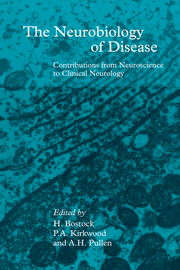Book contents
- Frontmatter
- Contents
- List of contributors
- Preface
- Part I Physiology and pathophysiology of nerve fibres
- Part II Pain
- Part III Control of central nervous system output
- 18 Synaptic transduction in neocortical neurones
- 19 Cortical circuits, synchronization and seizures
- 20 Physiologically induced changes of brain temperature and their effect on extracellular field potentials
- 21 Fusimotor control of the respiratory muscles
- 22 Cerebral accompaniments and functional significance of the long-latency stretch reflexes in human forearm muscles
- 23 The cerebellum and proprioceptive control of movement
- 24 Roles of the lateral nodulus and uvula of the cerebellum in cardiovascular control
- 25 Central actions of curare and gallamine: implications for reticular reflex myoclonus?
- 26 Pathophysiology of upper motoneurone disorders
- 27 Modulation of hypoglossal motoneurones by thyrotropin-releasing hormone and serotonin
- 28 Serotonin and central respiratory disorders in the newborn
- 29 Are medullary respiratory neurones multipurpose neurones?
- 30 Reflex control of expiratory motor output in dogs
- 31 Abnormal thoraco-abdominal movements in patients with chronic lung disease
- 32 Respiratory rhythms and apnoeas in the newborn
- 33 Cardiorespiratory interactions during apnoea
- 34 Impairment of respiratory control in neurological disease
- 35 The respiratory muscles in neurological disease
- Part IV Development, survival, regeneration and death
- Index
19 - Cortical circuits, synchronization and seizures
from Part III - Control of central nervous system output
Published online by Cambridge University Press: 04 August 2010
- Frontmatter
- Contents
- List of contributors
- Preface
- Part I Physiology and pathophysiology of nerve fibres
- Part II Pain
- Part III Control of central nervous system output
- 18 Synaptic transduction in neocortical neurones
- 19 Cortical circuits, synchronization and seizures
- 20 Physiologically induced changes of brain temperature and their effect on extracellular field potentials
- 21 Fusimotor control of the respiratory muscles
- 22 Cerebral accompaniments and functional significance of the long-latency stretch reflexes in human forearm muscles
- 23 The cerebellum and proprioceptive control of movement
- 24 Roles of the lateral nodulus and uvula of the cerebellum in cardiovascular control
- 25 Central actions of curare and gallamine: implications for reticular reflex myoclonus?
- 26 Pathophysiology of upper motoneurone disorders
- 27 Modulation of hypoglossal motoneurones by thyrotropin-releasing hormone and serotonin
- 28 Serotonin and central respiratory disorders in the newborn
- 29 Are medullary respiratory neurones multipurpose neurones?
- 30 Reflex control of expiratory motor output in dogs
- 31 Abnormal thoraco-abdominal movements in patients with chronic lung disease
- 32 Respiratory rhythms and apnoeas in the newborn
- 33 Cardiorespiratory interactions during apnoea
- 34 Impairment of respiratory control in neurological disease
- 35 The respiratory muscles in neurological disease
- Part IV Development, survival, regeneration and death
- Index
Summary
The epilepsies as a group are amongst the most common of neurological disorders, so that about 1% of the population experience more than one seizure during their lifetime. They provide a particularly fertile area for the interaction of basic neurophysiology and clinical neurology. Epileptic activity can be considered a pathological extreme of normal neuronal synchronization. Studies of experimental epilepsies both help us understand the fundamentals of the underlying disease processes and provide the impetus for basic research on brain function. They do indeed provide a ‘Window to Brain Mechanisms’ to borrow the title of an earlier monograph (Lockard & Ward, 1980).
A key feature of epileptic foci is the abrupt transition from apparently normal neuronal activity to the intense and synchronous discharge of many, if not all, of the neurones in the focus. The extent and duration of this synchrony varies. For present purposes we can divide discharges from epileptic foci into: brief and localized ‘interictal’ bursts, which last <200 ms; ‘polyspikes’ or ‘after-discharges’, which last several seconds but which also tend to remain localized at the focus; and ‘seizures’, which last tens of seconds up to 2 minutes, and which normally involve large areas of the brain, and may generalize into most of the neocortex, resulting in motor fits (Fig. 19.1). Normally epileptic seizures are self-limiting, but when these constraints fail status epilepticus results, which is a life-threatening medical emergency, and which is likely to cause substantial brain damage.
- Type
- Chapter
- Information
- The Neurobiology of DiseaseContributions from Neuroscience to Clinical Neurology, pp. 210 - 220Publisher: Cambridge University PressPrint publication year: 1996

